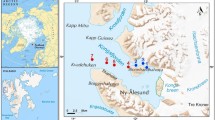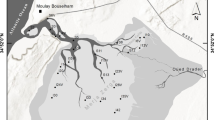Abstract
Benthic sampling between 1997 and 2006 on the Yermak Plateau, a permanently ice-covered submarine peninsula northwest of Svalbard, exhibited regional differences with generally higher meiofauna numbers in southern and western parts (~2,250–2,300 ind. 10 cm−2 in the south-west, compared with ~1,200–1,350 ind. 10 cm−2 in the north-east). Distribution patterns suggest a current-driven lateral input of POM, produced in the high-productive Marginal Ice Zone, with increased intensity along the western slope of the plateau. Significant correlations between comparably ‘fresh’ sediment-bound phytodetritus and the taxonomic composition of meiofauna assemblages indicate that food quality decisively affects the community structure. The long-term development of meiobenthic communities showed no clear trend; however, a comparison of summer and winter data exhibited higher meiofauna densities and a more diverse composition in July samples. The predominance of small nematodes in the summer samples might point to reproductive activities stimulated by increased food availability. The taxonomic composition of nematode assemblages showed distinct regional differences, thereby indicating more stable environmental conditions in north-eastern parts of the Yermak Plateau.










Similar content being viewed by others
References
Antoine D, André J-M, Morel A (1996) Oceanic primary production. 2. Estimation at global scale from satellite (coastal zone color scanner) chlorophyll. Global Biogeochem Cycles 10:57–69
Barnett PRO, Watson J, Connelly D (1984) A multiple corer for taking virtually undisturbed samples from shelf, bathyal and abyssal sediments. Oceanol Acta 7:399–408
Behrenfeld MJ, Falkowski PG (1997) Photosynthetic rates derived from satellite-based concentration. Limnol Oceanogr 42:1–28
Birgel D, Stein R, Hefter J (2004) Aliphatic lipids in recent sediments of the Fram Strait/Yermak Plateau (Arctic Ocean): composition, sources and transport processes. Mar Chem 88:127–160
Boetius A, Lochte K (1994) Regulation of microbial enzymatic degradation of OM in deep-sea sediments. Mar Ecol Prog Ser 104:299–307
Bongers T (1990) The maturity index: an ecological measure of environmental disturbance based on nematode species composition. Oecologia 83:14–19
Bongers T, Alkemade R, Yeates GW (1991) Interpretation of disturbance-induced maturity decrease in marine nematode assemblages by means of Maturity Index. Mar Ecol Prog Ser 76:135–142
Clarke KR, Gorley RN (2006) Primer v5: user manual/tutorial. PRIMER-E, Plymouth, p 91
Damm E (1997) Oxygen. In: Stein R, Fahl K (eds) Scientific cruise report of the Arctic expedition ARK-XIII/2 of RV “Polarstern” in 1997. Rep Polar Res 255, pp 138–140
De Grisse AT (1969) Redescription ou modification de quelques techniques utilisées dans l’étude de nematodes phytoparasitires. Meded Rijsfakulteit Landbouwneten-scheppen Gent 34:351–369
Ducklow HW, Doney SC, Steinberg DK (2009) Contributions of long-term research and time-series observations to marine ecology and biogeochemistry. Annu Rev Mar Sci 1:279–302
Findlay RH, Dobbs FC (1993) Quantitative description of microbial communities using lipid analysis. In: Kemp PF (ed) Handbook of methods in aquatic microbial ecology. Lewis, Boca Raton, pp 271–284
Findlay RH, King GM, Watling L (1989) Efficiency of phospholipid analysis in determining microbial biomass in sediments. Appl Environ Microbiol 55:2888–2893
Fontanier C, Jorissen FJ, Chaillou G, David C, Anschutz P, Lafon V (2003) Seasonal and interannual variability of benthic foraminiferal faunas at 550 m depth in the Bay of Biscay. Deep Sea Res 50:457–494
Hargrave BT, von Bodungen B, Stoffyn-Egli P, Mudies PJ (1994) Seasonal variability in particle sedimentation under permanent ice cover in the Arctic Ocean. Cont Shelf Res 14:279–293
Hasemann C (2006) Kleinskalige Heterogenität in der arktischen Tiefsee: Einfluß kleiner Kaltwasser-Schwämme auf die Diversität benthischer Nematoden-Gemeinschaften. PhD thesis, Uni Bremen, Germany, pp 285
Hoste E, Vanhove S, Schewe I, Soltwedel T, Vanreusel A (2007) Spatial and temporal variations in deep-sea meiofauna assemblages in the Marginal Ice Zone of the Arctic Ocean. Deep Sea Res I 54:109–129
Hurlbert SH (1971) The non-concept of species diversity: a critique and alternative parameters. Ecol 52:577–586
Jensen P (1987) Feeding ecology of free-living aquatic nematodes. Mar Ecol Prog Ser 35:187–196
Jensen P (1988) Nematode assemblages in the deep-sea benthos of the Norwegian Sea. Deep Sea Res I 35:1173–1184
Köster M, Jensen P, Meyer-Reil L-A (1991) Hydrolytic activity associated with organisms and biogenic structures in deep-sea sediments. In: Chrost R (ed) Microbial enzymes in aquatic environments. Springer, Berlin, pp 298–310
Krebs CJ (1998) Ecological Methodology, 2nd edn. Harper Collins, New York, p 620
Levin LA, Etter RJ, Rex MA, Gooday AJ, Smith CR, Pineda J, Stuart CT, Hessler RR, Pawson D (2001) Environmental influences on regional deep-sea species diversity. Annu Rev Ecol Syst 31:51–93
Lorenzen S (1981) Entwurf eines phylogenetischen Systems der freilebenden Nematoden. Veröff Inst Meeresforsch Bremerhaven 7, pp 472
Manley O (1995) Branching of Atlantic Water within the Greenland-Spitsbergen passage: an estimate of recirculation. J Geophys Res 100(C10):20627–20634
Muthumbi AW, Vanreusel A, Duineveld G, Soetaert K, Vincx M (2004) Nematode community structure along the continental slope off the Kenyan Coast, Western Indian Ocean. Internat Rev Hydrobiol 89:188–205
Pfannkuche O, Thiel H (1988) Sample processing. In: Higgens RP, Thiel H (eds) Introduction to the study of meiofauna. Smithsonian Institute Press, Washington DC/London, pp 134–145
Pielou EC (1966) The measurement of diversity in different types of biological collections. J Theor Biol 13:131–144
Primer-e (2006) PRIMER 6.1.6 for windows: plymouth routines in multivariate ecological research. Primer-e, Plymouth
Rachor E, Denisenko S (1997) Macrofauna: Quantitative Assessment. In: Stein R, Fahl K (eds) Scientific cruise report of the Arctic expedition ARK-XIII/2 of RV “Polarstern” in 1997. Rep Polar Res 255, pp 70–77
Renaud PE, Ambrose WG, Vanreusel A, Clough LM (2006) Nematode and macrofaunal diversity in central Arctic Ocean benthos. J Exp Mar Biol Ecol 330:297–306
Ritzrau W (1996) Microbial activity in the benthic boundary layer: small-scale distribution and its relationship with the hydrodynamic regime. Neth J Sea Res 36:171–180
Rutgers van der Loeff MM, Meyer R, Rudels B, Rachor E (2002) Resuspension and particle transport in the benthic nepheloid layer in and near Fram Strait in relation to faunal abundances and 234Th depletion. Deep Sea Res 49:1941–1958
Sakshaug E (1997) Biomass and productivity distributions and their variability in the Barents Sea. ICES J Mar Sci 54:341–350
Sakshaug E, Skjodal HR (1989) Life at the ice-edge. Ambio 18:60–67
Sanders HL (1968) Marine benthic diversity: a comparative study. Am Nat 102(925):243–282
Sanders HL (1969) Benthic marine diversity and the stability-time hypothesis. In: Brookhaven Symposia on Biology 22, pp 71–81
Schewe I, Soltwedel T (2003) Benthic response to ice-edge induced particle flux in the Arctic Ocean. Polar Biol 26:610–620
Shannon CE, Weaver W (1963) The mathematical theory of communication. University of Illinois Press, Urbana
Shuman FR, Lorenzen CF (1975) Quantitative degradation of chlorophyll by a marine herbivore. Limnol Oceanogr 20:580–586
Smith CR, De Leo FC, Bernardino AF, Sweetman AK, Martinez Arbizu P (2008) Abyssal food limitation, ecosystem structure and climate change. Trends Ecol Evol 23:518–528
Soetaert K, Heip C (1995) Nematode assemblages of deep-sea and shelf break sites in the North Atlantic and Mediterranean Sea. Mar Ecol Prog Ser 125:171–183
Sokal RR, Rohlf FJ (1994) Biometry: the principles and practice of statistics in biological research, 3rd edn. WH Freeman, New York, p 880
Soltwedel T, Pfannkuche O, Thiel H (1996) The size structure of deep-sea meiobenthos in the North-Eastern Atlantic: nematode size spectra in relation to environmental variables. J Mar Biol Assoc UK 76:327–344
Soltwedel T, Mokievsky V, Schewe I (2000) Benthic activity and biomass on the Yermak Plateau and in adjacent deep-sea regions northwest of Svalbard. Deep Sea Res 47:1761–1785
StatSoft Inc (2005) STATISTICA for windows. StatSoft Inc, Tulsa
Steyaert M, Moodley L, Nadong T, Moens T, Soetaert K, Vincx M (2007) Responses of intertidal nematodes to short-term anoxic events. J Exp Mar Biol Ecol 345:175–184
Thiel H (1978) Benthos in upwelling regions. In: Boje R, Tomczak M (eds) Upwelling ecosystems. Springer, Berlin, pp 124–138
Thiel H, von Juterzenka K, Klages M, Kulescha F, Sablotny S (1997) Epifauna/Megafauna: quantitative assessment. In: Stein R, Fahl K (eds) Scientific cruise report of the Arctic expedition ARK-XIII/2 of RV “Polarstern” in 1997. Rep Polar Res 255, pp 67–70
Tietjen JH (1989) Ecology of deep-sea nematodes from the Puerto Rico Trench area and Hatteras Abyssal Plain. Deep Sea Res I 10:1579–1594
Vanaverbeke J, Arbizu PM, Dahms H-U, Schminke HK (1997a) The metazoan meiobenthos along a depth gradient in the Arctic Laptev Sea with special attention to nematode communities. Polar Biol 18:391–401
Vanaverbeke J, Soetaert K, Heip C, Vanreusel A (1997b) The metazoan meiobenthos along the continental slope of the Goban Spur (NE Atlantic). J Sea Res 38:93–107
Vanhove S, Arntz WE, Vincx M (1999) Comparative study of the nematode communities on the southeastern Weddell Sea shelf and slope (Antarctica). Mar Ecol Prog Ser 181:237–256
Vanreusel A, Clough L, Jacobsen K, Ambrose W, Jivaluk J, Ryheul V, Herman R, Vincx M (2000) Meiobenthos of the central Arctic Ocean with special emphasis on the nematode community structure. Deep Sea Res I 47:1855–1879
Vincx M, Bett BJ, Dinet A, Ferrero T, Gooday AJ, Lambshead PJD, Pfannkuche O, Soltwedel T, Vanreusel A (1994) Meiobenthos of the deep Northeast Atlantic. Adv Mar Biol 30:1–88
Wheeler PA, Gosselin M, Sherr E, Thibault D, Kirchman DL, Benner R, Whitledge TE (1996) Active cycling of organic carbon in the central Arctic Ocean. Nature 380:697–699
Wieser W (1953) Die Beziehung zwischen Mundhöhlengestalt, Ernährungsweise und Vorkommen bei freilebenden marinen Nematoden. Arkiv för Zoologi 4:439–484
Wieser W (1960) Benthic studies in Buzzards Bay. II. The meiofauna. Limnol Oceanogr 5:121–137
Acknowledgments
We wish to thank the crews of RV ‘Polarstern’ and RV ‘Maria S. Merian’ for their helpful support during the expeditions between 1997 and 2006, and Anja Pappert, Daniela Freese, Anne-Maria Grave and Stephanie Simon for assistance with the measurements of various biogenic sediment compounds, bacterial counts and the meiofauna sortings. We also gratefully acknowledge two anonymous reviewers for their valuable comments on the manuscript. This is publication awi-n17512 of the Alfred Wegener Institute for Polar and Marine Research, Bremerhaven, Germany.
Author information
Authors and Affiliations
Corresponding author
Rights and permissions
About this article
Cite this article
Soltwedel, T., Mokievsky, V., Schewe, I. et al. Yermak Plateau revisited: spatial and temporal patterns of meiofaunal assemblages under permanent ice-coverage. Polar Biol 32, 1159–1176 (2009). https://doi.org/10.1007/s00300-009-0612-7
Received:
Revised:
Accepted:
Published:
Issue Date:
DOI: https://doi.org/10.1007/s00300-009-0612-7




